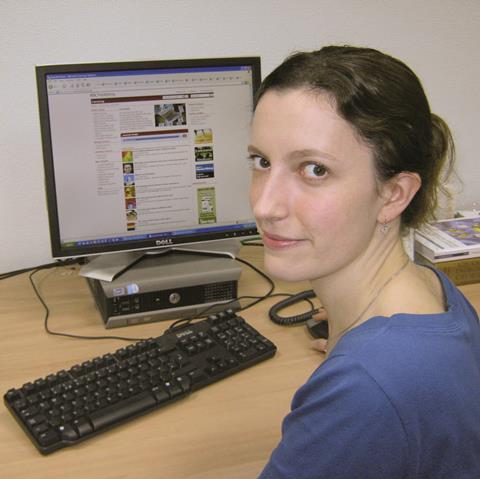Celia Gitterman has spent the past four years working for the Royal Society of Chemistry as a technical editor. She talks to Tom Bond about her typical day

As part of its activities the Royal Society of Chemistry (RSC) publishes 27 journals, which are made up of articles submitted by chemists. Over 120 people work on these journals in the RSC’s Cambridge office. Each article is accepted for publication by a journal’s editor based on positive comments received from experts with knowledge of the subject area. Part of the informatics department and working in a team of 10 staff responsible for six journals, Celia’s job is to make sure the accepted articles are ready to be published on the Internet and in print.
Journals production
Working from nine to five each day, Celia edits and proofs the accepted articles, and compiles these into issues of the journals. When articles have been accepted for publication, electronic versions of the manuscripts are sent to typesetters in India, who convert them into an XML (extensible markup language) format. In this format different types of text (eg italics, bold, captions references etc) are marked in different colours, which helps Celia as she edits the article. ‘When editing the text, we check the spelling, the references and that it makes sense’, she explains. Using her knowledge of chemistry to understand the articles, Celia spots any mistakes in the chemistry and adds corresponding queries for the authors to address on the final proof. Graphics, eg illustrations, diagrams etc, in the article go through a similar process as the text and she also verifies that these are the correct size to be reproduced clearly in the final version. Celia takes up to a couple of hours to edit a short, four-page article. Review articles, which summarise research in a particular area of chemistry, take longer to edit since these can be up to 25 pages.
Proofing papers
Once Celia is happy with the edited article, she uses software to generate a proof of the article similar in appearance to the final version but which includes questions for the authors on any sections she is uncertain of. This is sent to the authors by e-mail and when they return the proof, she includes their corrections in the final article. She then makes a final check of the article’s content and layout before publishing it on the Internet in HTML (hyper text markup language) format.
When the HTML version of the article is published, the typesetters create a PDF (portable document format) file which is used for the print and electronic versions of the issue. The journals Celia works on are published either weekly or monthly and it is her role to collect articles and combine them to form an issue of a particular journal. This is called makeup and takes between half a day and a day. ‘We check the layout of the PDFs for the issue. If everything’s fine we’ll publish the electronic issue. Then the PDFs get sent to the printers’ for the print issue’.
Celia edits and proofs about five articles per day. As and when required she spends some of her day creating ontologies for chemical reactions. These are like dictionaries to define reactions to which links can be added in the HTML versions of the articles.
Attention to detail
‘You have to be quite picky to do this job, and it helps if you enjoy reading’, says Celia. For her it’s very satisfying to edit a manuscript and spot changes that help to make the chemistry clearer.
Pathway to success
2004–present, technical editor, Royal Society of Chemistry, Cambridge
2000–04, PhD in organic chemistry at University of Cambridge
1996–2000, MSci in natural sciences at University of Cambridge
1994–96, chemistry, maths, physics A-levels, Sacred Heart of Mary Girls’ School, Upminster
Originally published in Infochem






No comments yet